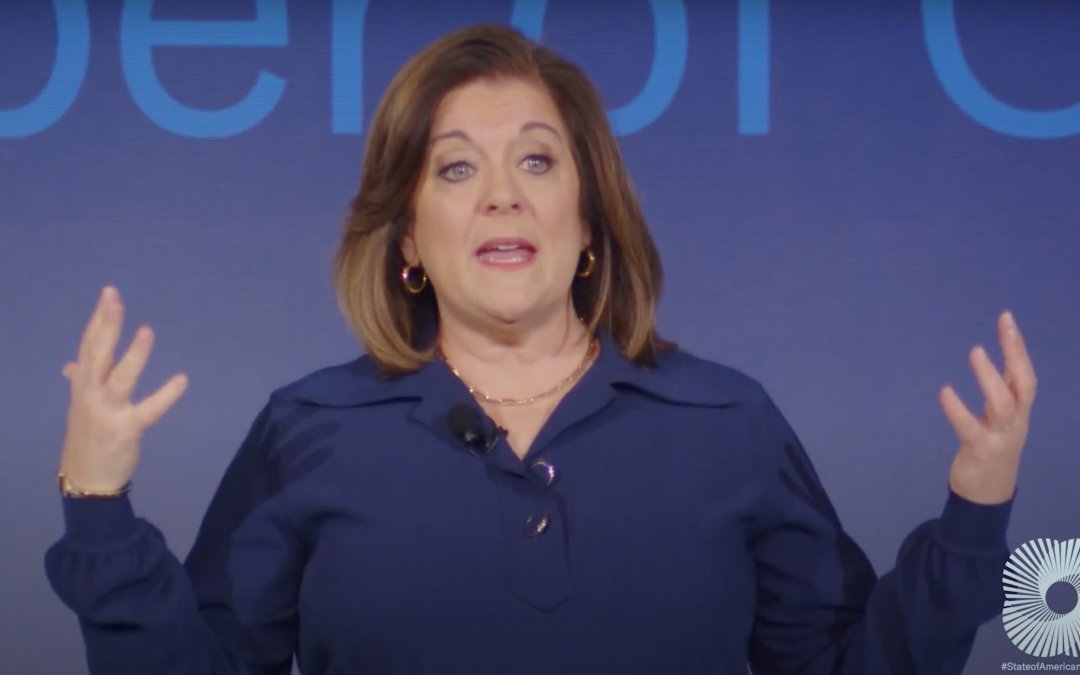WASHINGTON — The leader of the U.S. Chamber of Commerce emphatically praised American free enterprise and innovation at the Chamber’s annual State of American Business address.
“The State of American Business is optimistic,” said Suzanne P. Clark, president and CEO of the U.S. Chamber of Commerce to the nearly ten thousand viewers tuning in virtually from around the world. Clark said this optimism is evidenced by the volume of business formation this past year, which clocked in at 5.6 million business applications according to the United States Census. This is the highest yearly figure on record.
“Free enterprise has made life simpler and better for everyone by scaling technologies, expanding choice, driving down prices, and boosting every American’s buying power,” Clark declared. She later added, “When you make a five-year plan or when you simply show up for work and give the best of what you’ve got–your energy, your ideas, your talent–it’s all optimism.”
Much like last year’s address, Clark primed her keynote speech by addressing the percolating pessimism towards the economy and government.
“Does America have challenges? You bet we do. Are we, at the U.S. Chamber of Commerce, pessimistic about it? Not on your life,” Clark stated strongly. “All of us at the U.S. Chamber wants to counter-program against the negativity,” she reprised later.
While the Chamber president lauded the power of free enterprise, Microsoft Vice Chair and President Brad Smith heartily endorsed AI as a supplemental force to businesses this year. He laid out three main applications of AI for tasks related to core business procedures, such as pharmaceutical companies using it for drug discovery, back office functions like human resources, finance and legal, and finally in an emergent application Smith calls a “co-pilot”, in which workers use AI to streamline work done on software like Microsoft, Word, Excel, and more.
“People’s jobs will change–even if it’s not a new job or a job that goes away,” he added.
Even so, Smith stressed that humans must remain in control of the technology.
“Unless we have some regulation, we’re likely to have market failure,” said Smith, citing a report filed by an AI commission formed in the U.S. Chamber of Commerce in 2022. “That is not a sentence that most people would expect to see in the executive summary of a report from the American Chamber of Commerce, and yet it is precisely right.”

Microsoft Vice Chair and President Brad Smith delivers remarks on Jan. 11, 2024. (U.S. Chamber of Commerce)
While AI brings promising advancements to workforce productivity, it remains unclear how the economy will perform and affect businesses this year.
Clark’s speech came just hours after the release of the first U.S. inflation report of 2024. The Consumer Price Index has either remained steady or decreased since August 2023, falling from 3.7% to 3.4% over three months, according to the Bureau of Labor Statistics. The popular inflation proxy went up 0.3 percentage points this December.
“I think we’re expecting growth in 2024, perhaps slower growth than we saw in 2023,” Clark ventured. “I think we [America] remain the economic envy of the world in 2024.”
While the unprecedented uptick in inflation may have consumers spooked and sounding the alarms, Jai Kedia, Research Fellow at the Cato Institute Center for Monetary and Financial Alternatives, says it is wise to step back and consider the overall trend.
“The macroeconomy is constantly subjugated to external shocks that cause our macro indicators to sort of stray away from their mean value,” said Kedia. “Businesses do have reasons to be optimistic regarding inflation, at least because that does seem to be coming down.”
Kedia notes that the inflation cooldown did not cause a significant increase in the unemployment rate–a good indication that the economy is in for a much-desired “soft-landing”.
Even so, according to Kedia, high interest rates, induced by the Fed’s persistent contractionary policy, may continue to be a headwind facing businesses this year.
“With mortgage rates and auto loan rates and credit card rates being as high as they are, it’s likely that consumers respond by shrinking the amount of expensive durables that they buy, which is something businesses will have to contend with,” Kedia continued.
However, if inflation continues to flatline as a whole, momentum pressing the Fed on when they will start cutting rates will likely mount.
“Sometime later this year, the Fed will start to think about and most likely implement rate cuts–especially if there’s any increase in the unemployment rate at all.” Kedia said. “That’s almost certainly going to happen.”


